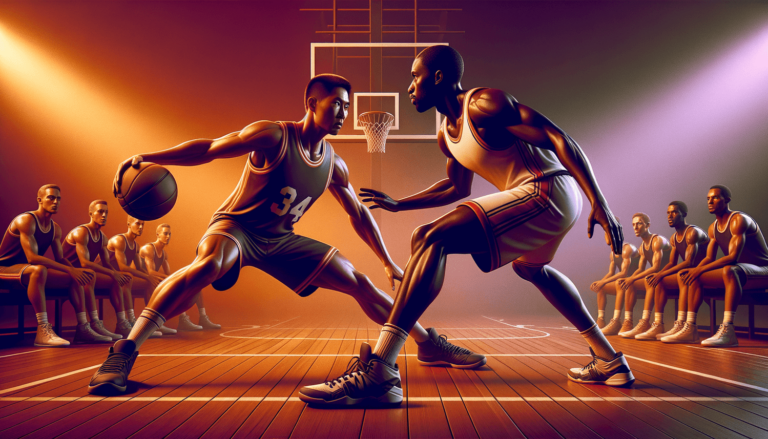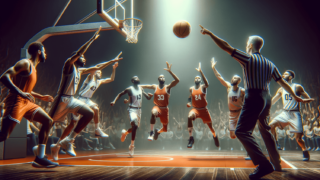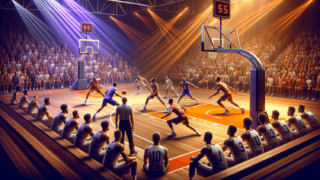
Understanding the Guarding Position Rule in Basketball
Written by: Basketball Universe
Last updated:

As the whistle blows and sneakers screech across the court, every basketball enthusiast knows how vital mastering the fundamentals is to the game. Enter the guarding position rule, a core tenet that promises to both protect players and level the playing field in this highly dynamic sport. In this thrilling blog post, we’ll navigate the intricacies of this essential rule, empowering you to better appreciate jaw-dropping matchups and refine your own hoop skills. So lace up your sneakers, assume your defensive stance, and join us as we penetrate the heart of the guarding position rule in basketball!
Understanding the Guarding Position Rule in Basketball
The guarding position rule in basketball establishes the criteria for legal defense, requiring the defender to maintain an initial legal guarding position before making any contact with an offensive player. This involves standing with both feet on the ground, facing the opponent, and providing enough space to allow normal basketball movements. The defender may then move laterally or backwards to maintain position but must avoid excessive physical contact or impeding the offensive player’s progress. Understanding and adhering to the guarding position rule helps promote cleaner and safer gameplay on the court.
A Deep Dive into the Key Principles of the Guarding Position Rule
Although the guarding position rule may seem straightforward, it’s essential to break down its core principles to truly harness its potential. For the benefit of all basketball aficionados, we’ll explore these principles in detail and occasionally toss in some fascinating tidbits for added enjoyment.
Establishing Initial Legal Guarding Position
As previously mentioned, acquiring an initial legal guarding position forms the cornerstone of this rule. To do so, a defender must have both feet firmly planted on the ground, with their torso facing the offensive player. It’s crucial to provide the opponent enough space to perform their customary basketball moves as well. Keep in mind that the guarding position isn’t just about defense—it directly affects offensive maneuvers, too!
Key Takeaway: Be the Brick Wall while Giving Space!
Basketball rules demand that defenders act strategically, essentially becoming a solid roadblock for their opponents. Establishing a proper initial legal guarding position helps minimize fouls, enabling defenders to focus on stopping their rivals rather than earning penalty points.
Agility and Movement: Shadowing the Offensive Player
Once they have nailed down the initial legal guarding position, defenders are free to move alongside offensive players. While tracking their opponents’ moves, they can travel laterally, forward, or backward—just be wary of creating excessive contact!
Expert Tip: Perfect the Defensive Slide
A critical part of maintaining a legal guarding position involves mastering the defensive slide. This technique can assist players in staying within the framework of basketball rules, ensuring swift defensive moves while minimizing the risk of fouls.
Anticipating and Reacting to Offensive Player’s Movements
As the offensive player advances, positioning becomes even more critical. The defender must predict and respond to these advancements, while maintaining their legal guarding position, to effectively block the opponent’s path and impede scoring attempts.
Key Takeaway: Develop Lightning-Quick Reflexes and Play Smart
Fast reflexes can make all the difference on the court, especially when it comes to adopting a legal guarding position. Enhancing your reaction times and mental fortitude can turn you into an indomitable defensive machine, forcing opponents to contend with your precise and agile movements.
Decoding Often Overlooked Aspects of the Guarding Position Rule
While we’ve outlined essential principles of the guarding position rule, some of its subtleties often fly under the radar. Here, we’ll decode these finer aspects to ensure your understanding of this rule is truly comprehensive.
Discerning Legal Contact from Illegal Contact
In basketball, physical contact affords a healthy dose of complexity to games. It’s crucial to differentiate between legal and illegal types of contact:
- Legal Contact: When the defensive player initiates contact from a legal guarding position, absorbs contact from the offensive player, or maintains their balance, the contact is considered legal.
- Illegal Contact: If the defensive player moves into the offensive player’s path, causing excessive bodily contact or creating undue obstruction, it is deemed illegal contact and often results in a foul.
Distinguishing Factor: Intent Matters!
Intent plays a significant role in differentiating between legal and illegal contact. A defensive player’s primary goal should be maintaining their guarding position and ensuring the offensive player’s moves are limited—not focusing on direct physical contact.
The Roles of Cylinder and Verticality Principles
Two interrelated concepts, the cylinder and verticality principles, comprise a critical portion of basketball rules, particularly the guarding position rule:
- Cylinder: Envision an imaginary cylinder that extends from the court’s surface to the ceiling, encapsulating a player’s body. Ideally, all parts of a player’s body should remain within this cylinder when making contact.
- Verticality: Verticality refers to the right of an airborne player, offensive or defensive, to occupy the space within their designated cylinder. If an opponent breaches this cylinder, causing contact, a foul may be called.
Key Takeaway: Respect Personal Space!
Always visualize the cylinder around each player and strive to respect their personal space. The cylinder and verticality principles emphasize fair play and sportsmanship while minimizing unnecessary contact and potential injuries on the court.
Sharpening Your Defensive Prowess: Tips and Drills
Now that we’ve dissected the guarding position rule, it’s time to arm you with drills and tactics to elevate your defensive game.
Working on the Stance
A proper defensive stance comprises the backbone of any top-notch defensive player. Start with your feet shoulder-width apart, knees bent, and chest up. Practicing this stance consistently will make it second nature, enabling you to more effectively execute the guarding position rule.
Improve Lateral Quickness
Channel your inner gazelle with exercises designed to boost your lateral quickness. Drills like the lateral shuffle, defensive slides, and agility ladder sprints can significantly enhance your lateral speed, making you a fearsome presence on defense.
Master the Closeout
The closeout technique requires defenders to quickly reach their assigned players, particularly sharpshooters, without allowing a convenient scoring opportunity. Test your closeout skills by having a partner catch a pass and shoot while you sprint towards them in an attempt to block their shot legally.
Expert Tip: Hold Onto Your Hats, We Have a Bonus Strategy!
Don’t forget to work on your fakes! A well-executed fake can be a game-changer for defenders, causing offensive players to second-guess their moves and potentially bungle their plays.
Unleash Your Basketball Knowledge to Dominate the Court
Armed with an in-depth understanding of the guarding position rule, analysis of its subtleties, and various drilling techniques, you’re well-prepared to tackle your next basketball game with renewed vigor. As we’ve illustrated, grasping this vital aspect of basketball rules is essential for players of all skill levels. So, get out there, stand firm, and dominate the court, one legal guarding position at a time!
Unlocking the Secrets to Avoiding Fouls in the Guarding Position
While we’ve thoroughly examined the guarding position rule thus far, there’s one critical aspect that merits special attention: how to avoid common fouls that arise from improper guarding position. A firm understanding of these fouls will enable you to make better decisions on the court and minimize penalty points.
Block and Charge Fouls: Navigating the Tricky Balance
Two prevalent fouls related to the guarding position rule are blocking and charging fouls, and distinguishing between them is essential:
- Blocking Fouls: A blocking foul occurs when a defender impedes the offensive player’s path without establishing a legal guarding position. In such cases, the foul is called on the defender, resulting in free throws or a change of possession.
- Charge Fouls: On the other hand, a charge foul takes place when an offensive player creates excessive contact with a defender who has already established a legal guarding position. This foul is called against the offensive player, awarding possession to the defensive team.
Point to Ponder: Timing is Everything!
It’s crucial for both offensive and defensive players to time their moves correctly—the slightest miscalculation can result in either a block or charge foul. Mastery of the guarding position rule is the foundation for avoiding these errors on the court.
Hand-Checking Fouls: Know Your Boundaries
Hand-checking refers to a defender extending their arm to maintain contact with the offensive player. While using their hands for positioning can be advantageous in certain scenarios, excessive contact or intentional shoves can lead to hand-checking fouls being called against the defender.
Key Takeaway: Keep Your Hands to Yourself!
Physical contact should only be incidental in legal guarding position situations. Just remember that using your hands excessively to restrain offensive players can incur fouls that give opponents a significant advantage.
Over-the-Back Fouls: Limiting Excess Contact in Rebounds
When competing for a rebound, the over-the-back foul comes into play. This foul is usually called against a player who goes “over the back” of an opponent during a rebound attempt, creating excessive or unnecessary contact. Being mindful of your positioning while guarding is essential to avoiding over-the-back fouls.
Defensive Tip: Box Out and Rebound Smartly
To prevent over-the-back fouls, players should focus on boxing out their opponents by establishing position and maintaining legal contact. Proper positioning and boxing out can help snag those coveted rebounds without succumbing to fouls.
Putting the Final Puzzle Pieces Together
With a comprehensive knowledge of the guarding position rule in basketball and its impact on various fouls, you’re now fully equipped to face opponents head-on and avoid costly penalties. Remember, while mastering the guarding position rule is crucial, all aspects of the game are interconnected. Continue honing your skills, learning from your experiences, and staying abreast of the rules to become an unstoppable force on the court!
Frequently Asked Questions about the Guarding Position Rule in Basketball
Are you still craving more insight into the guarding position rule? Look no further—below, we’ve compiled a list of frequently asked questions to further quench your thirst for basketball knowledge. Tackle these queries for a deeper grasp of this essential defensive rule.
1. Can a defender still be called for a foul while in a legal guarding position?
Yes, even if a defender has established a legal guarding position, they can still be called for a foul if they initiate excessive or unnecessary contact.
2. Can a defender use their hands to protect their legal guarding position?
Defenders may lightly use their hands to maintain balance or protect their position, but excessive or forceful contact can lead to hand-checking fouls.
3. What constitutes a legal guarding position when the offensive player has their back to the basket?
The same principles apply: the defender must have both feet on the ground and face the opponent, providing enough space for the offensive player to make normal basketball moves. The key is to avoid impeding the offensive player’s progress with excessive contact.
4. How can I improve my lateral movement while maintaining a legal guarding position?
Focus on drills like the lateral shuffle, defensive slides, or agility ladder sprints. These exercises help improve agility, quickness, and balance, all crucial factors in maintaining a legal guarding position during lateral movement.
5. Can a defender take a charge if they’re inside the restricted area under the basket?
No, defenders cannot draw a charge within the restricted area under the basket. If the defender establishes their position within this zone, any contact will result in a blocking foul rather than a charge.
6. How do I know if the contact made was illegal in the guarding position?
Illegal contact typically occurs when a defender creates excessive bodily contact or undue obstruction, usually by moving into the offensive player’s path without being in a legal guarding position first.
7. Can a defender jump vertically to block a shot without committing a foul?
Yes, as long as the defender maintains their vertical position within the imaginary cylinder, they may jump to block a shot without committing a foul. If contact does occur, the fault lies with the offensive player for encroaching on the defender’s space.
8. Can a defender receive the benefit of the doubt if contact is minimal?
While referees aim to make fair calls, some contact may go unnoticed if it doesn’t impede the offensive player or is considered incidental. However, always exercise caution to avoid potential fouls.
9. What’s the best approach for a smaller player guarding a larger opponent?
Focus on agility, quick reflexes, and anticipation. Smaller
Featured Posts
- No pillar pages found.





